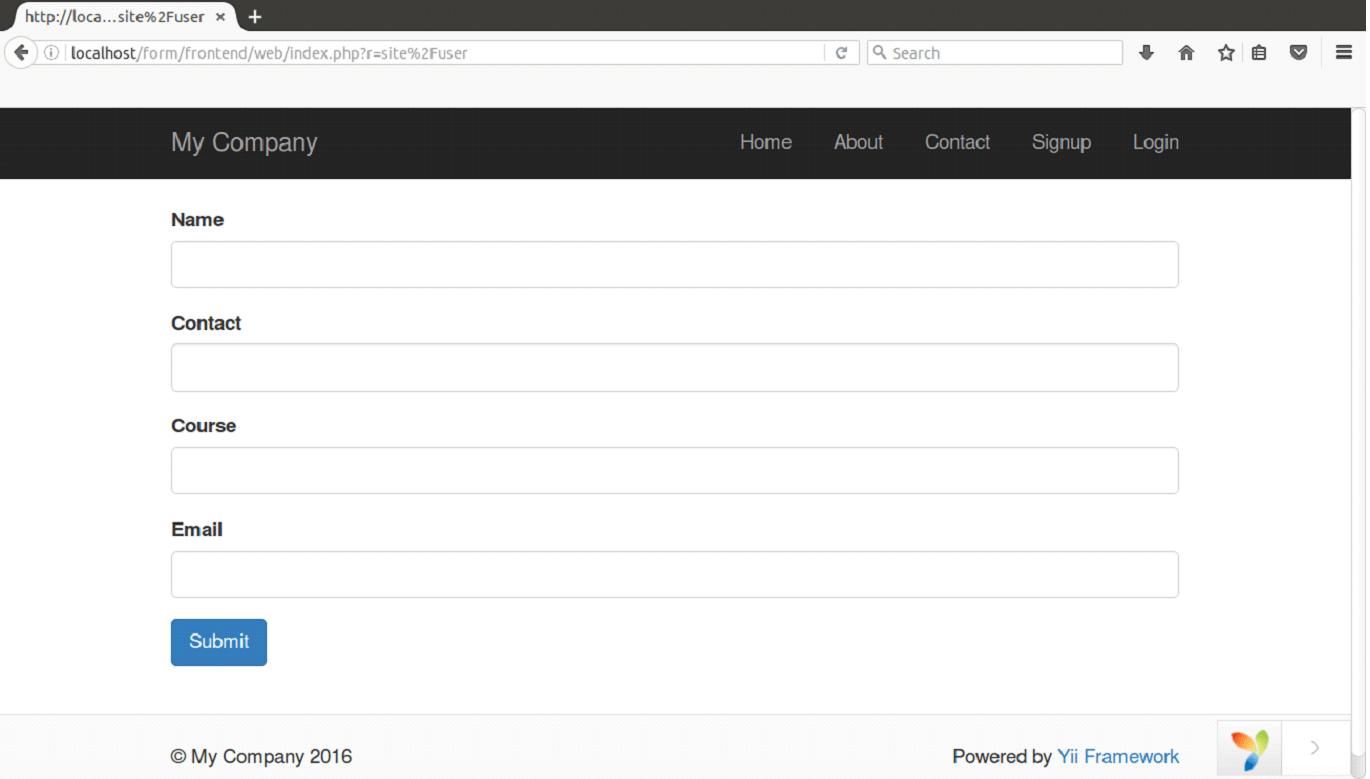配置项(Configuration)
说到配置项,读者朋友们第一反应是不是Yii的配置文件?这是一段配置文件的代码:
return [
'id' => 'app-frontend',
'basePath' => dirname(__DIR__),
'bootstrap' => ['log'],
'controllerNamespace' => 'frontend\controllers',
'components' => [
'db' => [
'class' => 'yii\db\Connection',
'dsn' => 'mysql:host=localhost;dbname=yii2advanced',
'username' => 'root',
'password' => '',
'charset' => 'utf8',
],
... ...
'cache' => [
'class' => 'yii\caching\MemCache',
'servers' => [
[
'host' => 'cache1.digpage.com',
'port' => 11211,
'weight' => 60,
],
[
'host' => 'cache2.digpage.com',
'port' => 11211,
'weight' => 40,
],
],
],
],
'params' => [...],
];
Yii中许多地方都要用到配置项,Yii应用自身和其他几乎一切类对象的创建、初始化、配置都要用到配置项。 配置项是针对对象而言的,也就是说,配置项一定是用于配置某一个对象,用于初始化或配置对象的属性。 关于属性的有关内容,请查看 属性(Property) 。
配置项的格式
一个配置文件包含了3个部分:
- 基本信息配置。主要指如 id basePath 等这些应用的基本信息,主要是一些简单的字符串。
- components配置。配置文件的主体,也是我们接下来要讲的配置项。
- params配置。主要是提供一些全局参数。
我们一般讲的配置项是指component配置项及里面的子项。 简单来讲,一个配置项采用下面的格式:
[
'class' => 'path\to\ClassName',
'propertyName' => 'propertyValue',
'on eventName' => $eventHandler,
'as behaviorName' => $behaviorConfig,
]
作为配置项:
- 配置项以数组进行组织。
- class 数组元素表示将要创建的对象的完整类名。
- propertyName 数组元素表示指定为 propertyName 属性的初始值为 $propertyValue 。
- on eventName 数组元素表示将 $eventHandler 绑定到对象的 eventName 事件中。
- as behaviorName 数组元素表示用 $behaviorConfig 创建一个行为,并注入到对象中。 这里的 $behaviroConfig 也是一个配置项;
- 配置项可以嵌套。
其中, class 元素仅在特定的情况下可以没有。就是使用配置数组的时候,其类型已经是确定的。 这往往是用于重新配置一个已经存在的对象, 或者是在创建对象时,使用了 new 或 Yii::createObject() 指定了类型。 除此以外的大多数情况 class 都是配置数组的必备元素:
// 使用 new 时指定了类型,配置数组中就不应再有 class 元素
$connection = new \yii\db\Connection([
'dsn' => $dsn,
'username' => $username,
'password' => $password,
]);
// 使用 Yii::createObject()时,如果第一个参数指定了类型,也不应在配置数
// 组中设定 class
$db = Yii::createObject('yii\db\Connection', [
'dsn' => 'mysql:host=127.0.0.1;dbname=demo',
'username' => 'root',
'password' => '',
'charset' => 'utf8',
]);
// 对现有的对象重新配置时,也不应在配置数组中设定 class
Yii::configure($db, [
'dsn' => 'mysql:host=127.0.0.1;dbname=demo',
'username' => 'root',
'password' => '',
'charset' => 'utf8',
]);
上面的例子中,在没看到配置数组的内容前,已经可以确定对象的类型了。 这种其他情况下,配置数组中如果再有一个 class 元素来设定类型的话,就不合理了。 这种情况下,配置数组不能有 class 元素。 但除此以外的其他情况,均要求配置数组提供 class 元素,以表示要创建的对象的类型。
配置项产生作用的原理
从 环境和配置文件 部分的内容,我们了解到了一个Yii应用,特别是高级模版应用,是具有许多个配置文件的, 这些配置文件在入口脚本 index.php 中被引入, 然后按照一定的规则合并成一个配置数组 $config 并用于创建Application对象。 具体可以看看 入口文件index.php 部分的内容。在入口脚本中,调用了:
$application = new yii\web\Application($config);
在 yii\web\Application 中,会调用父类的构造函数 yii\base\Application::__construct($config), 来创建Web Application。在这个构造函数中:
public function __construct($config = [])
{
Yii::$app = $this;
$this->setInstance($this);
$this->state = self::STATE_BEGIN;
// 预处理配置项
$this->preInit($config);
$this->registerErrorHandler($config);
// 使用 yii\base\Component::__construct() 完成构建
Component::__construct($config);
}
可以看到,其实分成两步,一是对 $config 进行预处理, 二是使用 yii\base\Component::__construct($config) 进行构建。
配置项预处理
预处理配置项的 yii\base\Application::preInit()方法其实在 别名(Alias) 部分讲过, 当时主要是从预定义别名的角度来讲的。现在我们再来完整地看看这个方法和有关的属性:
// basePath属性,由Application的父类yii\base\Module定义,并提供getter和setter
private $_basePath;
// runtimePath属性和vendorPath属性,Application都为其定义了getter和setter。
private $_runtimePath;
private $_vendorPath;
// 还有一个timeZone属性,Application为其提供了getter和setter,但不提供存
// 储变量。
// 而是分别调用 PHP 的 date_default_timezone_get() 和
// date_default_timezone_set()
public function preInit(&$config)
{
// 配置数组中必须指定应用id,这里仅判断,不赋值。
if (!isset($config['id'])) {
throw new InvalidConfigException(
'The "id" configuration for the Application is required.');
}
// 设置basePath属性,这个属性在Application的父类 yii\base\Module 中定义。
// 在完成设置后,删除配置数组中的 basePath 配置项
if (isset($config['basePath'])) {
$this->setBasePath($config['basePath']);
unset($config['basePath']);
} else {
throw new InvalidConfigException(
'The "basePath" configuration for the Application is required.');
}
// 设置vendorPath属性,并在设置后,删除$config中的相应配置项
if (isset($config['vendorPath'])) {
$this->setVendorPath($config['vendorPath']);
unset($config['vendorPath']);
} else {
// set "@vendor"
$this->getVendorPath();
}
// 设置runtimePath属性,并在设置后,删除$config中的相应配置项
if (isset($config['runtimePath'])) {
$this->setRuntimePath($config['runtimePath']);
unset($config['runtimePath']);
} else {
// set "@runtime"
$this->getRuntimePath();
}
// 设置timeZone属性,并在设置后,删除$config中的相应配置项
if (isset($config['timeZone'])) {
$this->setTimeZone($config['timeZone']);
unset($config['timeZone']);
} elseif (!ini_get('date.timezone')) {
$this->setTimeZone('UTC');
}
// 将coreComponents() 所定义的核心组件配置,与开发者通过配置文件定义
// 的组件配置进行合并。
// 合并中,开发者配置优先,核心组件配置起补充作用。
foreach ($this->coreComponents() as $id => $component) {
// 配置文件中没有的,使用核心组件的配置
if (!isset($config['components'][$id])) {
$config['components'][$id] = $component;
// 配置文件中有的,但并未指组件的class的,使用核心组件的class
} elseif (is_array($config['components'][$id]) &&
!isset($config['components'][$id]['class'])) {
$config['components'][$id]['class'] = $component['class'];
}
}
}
从上面的代码可以看出,这个 preInit() 对配置数组 $config 作了以下处理:
- id 属性是必不可少的。
- 从 $config 中拿掉了 basePath runtimePath vendorPath 和 timeZone 4个属性的配置项。 当然,也设置了相应的属性。
对 $config[‘components’] 配置项进行两方面的补充。 一是配置文件中没有的,而核心组件有的,把核心组件的配置信息补充进去。 二是配置文件中虽然也有,但没有指定组件的class的,使用核心组件配置信息指定的class。
基于此,我们不难得出如下结论:
- 有的配置项如 id 是不可少的,有的配置项如 basePath 等不用我们设置也是有默认值的。
- 对于核心组件,我们不配置也可以使用。
- 核心组件的ID是提前安排好的,没有充足的理由一般不要改变他,否则以后接手的人会骂你的。
- 核心组件可以不指明 class ,默认会使用预先安排的类型。
对于核心组件,不同的应用有不同的安排,这个我们可以看看,大致了解下,具体在于各应用的 coreComponents() 中定义:
// yii\base\Application 的核心组件
public function coreComponents()
{
return [
'log' => ['class' => 'yii\log\Dispatcher'], // 日志组件
'view' => ['class' => 'yii\web\View'], // 视图组件
'formatter' => ['class' => 'yii\i18n\Formatter'], // 格式组件
'i18n' => ['class' => 'yii\i18n\I18N'], // 国际化组件
'mailer' => ['class' => 'yii\swiftmailer\Mailer'], // 邮件组件
'urlManager' => ['class' => 'yii\web\UrlManager'], // url管理组件
'assetManager' => ['class' => 'yii\web\AssetManager'], // 前端资源管理组件
'security' => ['class' => 'yii\base\Security'], // 安全组件
];
}
// yii\web\Application 的核心组件,在基类的基础上加入Web应用必需的组件
public function coreComponents()
{
return array_merge(parent::coreComponents(), [
'request' => ['class' => 'yii\web\Request'], // HTTP请求组件
'response' => ['class' => 'yii\web\Response'], // HTTP响应组件
'session' => ['class' => 'yii\web\Session'], // session组件
'user' => ['class' => 'yii\web\User'], // 用户管理组件
'errorHandler' => ['class' => 'yii\web\ErrorHandler'], // 错误处理组件
]);
}
// yii\console\Application 的核心组件,
public function coreComponents()
{
return array_merge(parent::coreComponents(), [
'request' => ['class' => 'yii\console\Request'], // 命令行请求组件
'response' => ['class' => 'yii\console\Response'], // 命令行响应组件
'errorHandler' => ['class' => 'yii\console\ErrorHandler'], // 错误处理组件
]);
}
这些我们大致有个印象就够了,不用刻意去记住,用着用着你就自然记住了。
使用配置数组构造应用
在使用 preInit() 完成配置数组的预处理之后, Application构造函数又直接调用 yii\base\Component::__construct() 来构造Application对象。
结果这个 yii\base\Component::__construct() 也是个推委扯皮的家伙,他根本就没自己定义。 而是直接继承了父类的 yii\base\Object::__construct() 。因此,Application构造函数的最后一步, 实际上调用的是 yii\base\Object::__construct($config) 。 这个函数的原理,我们在 Object的配置方法 部分已经作出解释,这里就不再重复。
只是这里有两类特殊的配置项需要注意,就是以 on * 打头的事件和以 as * 打头的行为。 对于事件行为,可以阅读 事件(Event) 和 行为(Behavior) 部分的内容。
Yii对于这两类配置项的处理,是在 yii\base\Component::__set() 中完成的,从Component开始, 才支持事件和行为。具体处理的代码如下:
public function __set($name, $value)
{
$setter = 'set' . $name;
if (method_exists($this, $setter)) {
$this->$setter($value);
return;
// 'on ' 打头的配置项在这里处理
} elseif (strncmp($name, 'on ', 3) === 0) {
// 对于 'on event' 配置项,将配置值作为事件 handler 绑定到 evnet 上去
$this->on(trim(substr($name, 3)), $value);
return;
// 'as ' 打头的配置项在这里处理
} elseif (strncmp($name, 'as ', 3) === 0) {
// 对于 'as behavior' 配置项,将配置值作为创建Behavior的配置,创
// 建后绑定为 behavior
$name = trim(substr($name, 3));
$this->attachBehavior($name, $value instanceof Behavior ? $value
: Yii::createObject($value));
return;
} else {
$this->ensureBehaviors();
foreach ($this->_behaviors as $behavior) {
if ($behavior->canSetProperty($name)) {
$behavior->$name = $value;
return;
}
}
}
if (method_exists($this, 'get' . $name)) {
throw new InvalidCallException('Setting read-only property: ' .
get_class($this) . '::' . $name);
} else {
throw new UnknownPropertyException('Setting unknown property: '
. get_class($this) . '::' . $name);
}
}
从上面的代码中可以看到,对于 on event 形式配置项,Yii视配置值为一个事件handler,绑定到 event 上。 而对于 as behavior 形式的配置项,视配置值为一个Behavior,注入到当前实例中,并冠以 behavior 的名称。







